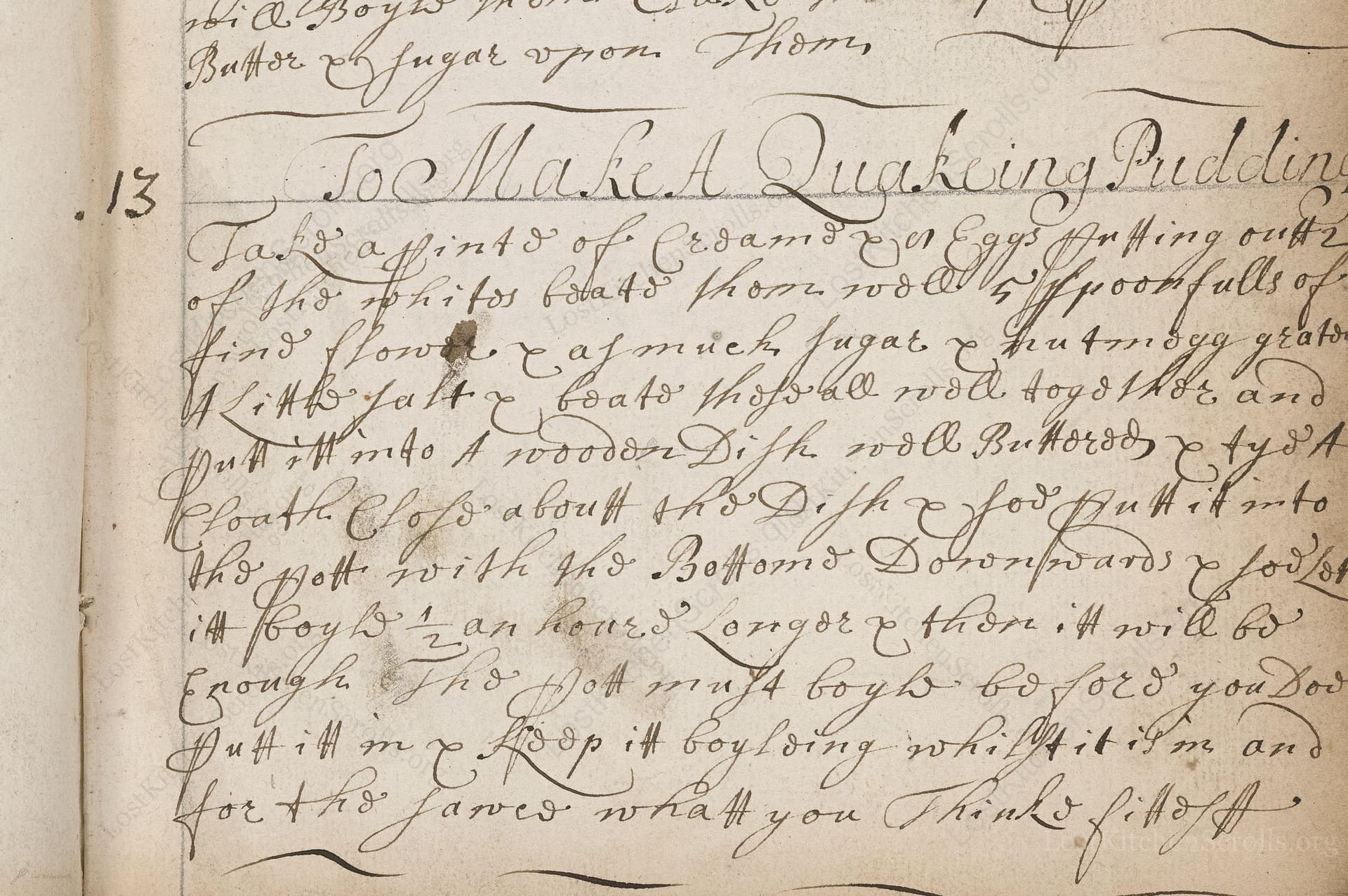To Make A Quakeing Pudding
From the treasured pages of Cookbook of Ann Smith, Reading
Written by Ann Smith

To Make A Quakeing Pudding
"Take a pinte of Creame & 9 Eggs puting out & of the whites beate them voell & put two or three spoonfulls of find Flower & as much sugar & nutmeg grated & a little salt & beate voell voell togdther. and put it into a wooden Dish &tie A Cloath Close about the Dish. &so put it into the pott with the Bottomd Downwards & so lett it Boyl ½ an houre's or longer & there it will be Enough. The pott must Boyle before you doe Putt it in & keep it boyling whilest it is in and for the same what you Thinke fittest."
Note on the Original Text
The recipe, like many of its era, is written without precise measurements, relying on the cook’s experience and judgment. Instructions are brief, using terms like ‘beate voell’ (pronounced as ‘beat well’) and omitting times or temperatures, as kitchen tools were not standardized. Spellings are irregular: ‘Creame’ for cream, ‘Flower’ for flour, and ‘Boyl’ for boil, reflecting the lack of standardized English spelling in the late 1600s. The narrative is fluid and conversational, expecting the reader to understand underlying techniques from context or custom.

Title
Cookbook of Ann Smith, Reading (1698)
You can also click the book image above to peruse the original tome
Writer
Ann Smith
Era
1698
Publisher
Unknown
Background
Step into the sumptuous kitchens of 17th-century England with Ann Smith’s culinary treasury, where traditional recipes and time-honored techniques invite you to savor the flavors of history. Each page promises a feast of inspiration and a glimpse into the artful dining of a bygone era.
Kindly made available by
Folger Shakespeare Library
This recipe originates from the late 17th century and is attributed to Ann Smith, who recorded it in 1698. The 'quakeing pudding' is an early English custard-style boiled pudding, a precursor to modern baked or steamed custards and flans. In an era before ovens were commonplace, gentle boiling or steaming in cloths was a standard household practice for puddings. Such recipes were common among households of means anticipating holiday feasts or special occasions. Ann Smith’s manuscript demonstrates the creativity and adaptability of home cooks in the Restoration period, where ingredients like eggs and cream signified both comfort and status, and where cookery manuscripts were prized family possessions passed through generations.

The recipe calls for a ‘wooden dish’ (a wooden bowl), a strong muslin or linen cloth to cover and tie the bowl, and a length of twine. Since there were no ovens, a large cauldron or kettle was used over an open fire. The cook would need a whisk (or bundle of twigs for beating eggs), a sturdy pot for boiling, and some sort of lifter or hook to remove the hot bowl safely from the boiling water.
Prep Time
15 mins
Cook Time
35 mins
Servings
6
We've done our best to adapt this historical recipe for modern kitchens, but some details may still need refinement. We warmly welcome feedback from fellow cooks and culinary historians — your insights support the entire community!
Ingredients
- 2 cups heavy cream
- 9 large eggs (using all yolks and about 5 of the whites)
- 2–3 tablespoons plain flour (0.7–1 oz)
- 2–3 tablespoons caster sugar (1–1.75 oz, adjust to taste)
- 1/4 teaspoon freshly grated nutmeg
- Pinch of salt
Instructions
- Begin by gently heating 2 cups of heavy cream in a saucepan, just until warm.
- In a bowl, beat 9 large eggs, discarding half of the whites (use about 5 egg whites and all 9 yolks).
- Whisk the eggs thouroughly until well combined.
- Add 2–3 tablespoons (about 0.7–1 oz) of plain flour, 2–3 tablespoons (about 1–1.75 oz) of caster sugar (to taste), freshly grated nutmeg (about 1/4 teaspoon), and a good pinch of salt.
- Whisk until the batter is smooth with no lumps.
- Pour this mixture into a heatproof bowl (preferably ceramic), cover the top tightly with a clean muslin or cotton cloth, and tie it securely with string.
- Fill a large pot with water and bring it to a boil.
- Once boiling, carefully lower the puding (bowl upside down) into the pot, ensuring the water comes at least halfway up the bowl.
- Keep the water at a steady boil and cook for 30–40 minutes.
- Lift out, untie, and serve warm—the pudding should tremble (or ‘quake’) on the plate.
Estimated Calories
315 per serving
Cooking Estimates
It takes about 15 minutes to prepare the ingredients and 35 minutes to cook the pudding. This recipe makes 6 servings, each with approximately 315 calories.
As noted above, we have made our best effort to translate and adapt this historical recipe for modern kitchens, taking into account ingredients nowadays, cooking techniques, measurements, and so on. However, historical recipes often contain assumptions that require interpretation.
We'd love for anyone to help improve these adaptations. Community contributions are highly welcome. If you have suggestions, corrections, or cooking tips based on your experience with this recipe, please share them below.
Join the Discussion
Rate This Recipe

Den Bockfisch In Einer Fleisch Suppen Zu Kochen
This recipe hails from a German manuscript cookbook compiled in 1696, a time whe...

Die Grieß Nudlen Zumachen
This recipe comes from a rather mysterious manuscript cookbook, penned anonymous...

Ein Boudain
This recipe comes from an anonymous German-language manuscript cookbook from 169...

Ein Gesaltzen Citroni
This recipe, dating from 1696, comes from an extensive anonymous German cookbook...
Browse our complete collection of time-honored recipes



